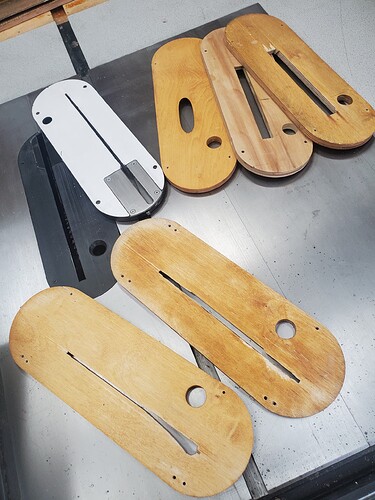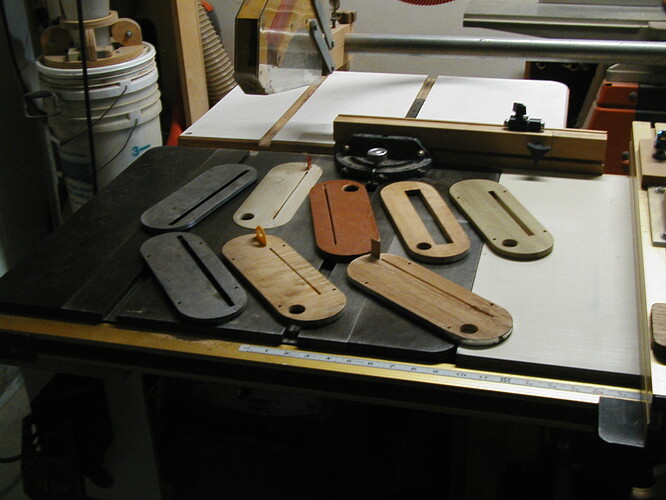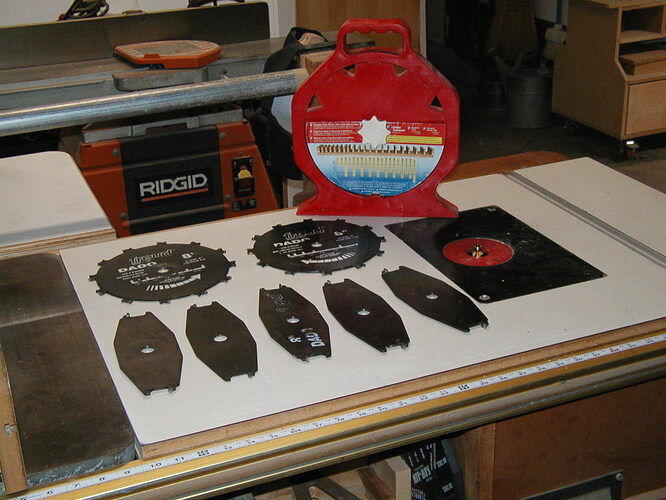Do we have a combination blade at the space? I have a project coming up that I need to put some dados in and since I’ve never been able to find any other throat plates for the saw figured I would just use multiple passes to do it. But I want the flat bottom that a combo blade leaves.
Inserts for the SawStop tablesaw would be a good project for the members who are looking for a project to complete on the CNC.
Once designed they can easily make several for various dado stacks as well.
Bill
I know there is a dado plate. Not yet sure what our blade assortment is
When I worked at Nordam we would make disposable plates to accommodate stack dado saw blades.
Would be helpful to cut a bunch of blanks out of some MDF (medium density fiberboard) then just back plunge whatever size is needed on the saw.
Additional training might be needed for backplunging technique.
Modern saws with their anti kickback pawls, riving knives and such have more problematic throat plate designs. The sawstop even more so with its lever locking mechanism. Good thing we’re tinkerers, cause I’d like to make a stack of fully functional saw stop type plates!
In some ways the saw stop design is easier to hack because it’s already thicker than most which are just a piece of approx 1/8" thick sheetmetal.
Aaron:
Here is my selection. My 70 year old Delta/Rockwell 8" tablesaw doesn’t have a riving knife so I use MJSplitters from MicroJig or wooden splitters except for the ones made for my dado stack.
These are made from a variety of materials. The two original metal ones, oak, poplar, maple, Phenolic plywood and the one I leave in most of the time which is Corian.
Bill
Not to go too far ot, but do you have a pic of your fence? Is that something you made?
I want to make some additional fences too. Let’s plasma cnc, mill, and weld!!!
Bill is a jig wizard. I suspect it’s an add on to a manufactured fence, probably an upgraded biesmeyer type. Also interested
Do we have a jig making class from time to time? I know knot heads tend to be masters of jig making. When I’m watching stuff on YouTube it’s not uncommon to see someone c clamp a pile of random wood to the bench, and stick a piece of wood in it, run it through some random equipment and Volia! A perfect whatever it is!
That’s not even including stuff like this guy
That guy should really consider using phenolic
Kazoo-height
James:
May I have permission to use your description of jig making in our Guild newsletter ? It expressed the process without getting bogged down in the details.
I suspect this is the same way you approach designing circuit boards. Just change some of the nomenclature - from wood, clamps and random equipment to wires, power supplies, resistors and capacitors.
Bill
Yes - all of my ramblings are by default under the creative commons unless its work related.
No- circuit design is all about flow. Because of the first rule of thermodynamics electronics is actually just the art of creatively inconveniencing electrons.
James:
I will defer to woodworkers with much more expertise than I have for a more comprehensive answer but I will attempt a response.
Jigs help us to mill wood into shapes safely but the wood has its own rules that are based on grain direction, moisture content, internal stresses that are released among other considerations. Similar to your first rule of thermodynamics only with an organic material.
Perhaps someone will come along and return this thread to its original topic 
Bill
We haven’t veered too far off. From my limited understanding the throat plate helps by covering the hole and gives a tighter clearance for less tear out and makes retrieval of fingers easier. My previous assumptions was that you made a blank, then put the saw blade all the way down, turned it on and brought the blade up. But I don’t think the inner part of the dado blade is… well bladed. So you would have to cut that out.
I’m just curious about throat plates because I have a table saw and have a few small things I’d like to use it for.
James:
The inner part of the dado stack is - to use your term - bladed. It uses a group of circular and elliptical shaped blades of different thicknesses depending on the desired width to be cut. This results in a pair of circular blades on the outside with the elliptical blades sandwiched between them.
On the circular blade the teeth are spaced around the circumference whereas the elliptical shaped blades have a tooth on their ends.
The resulting dado is cut to its full width with just a single pass.
I am describing a traditional dado stack. There is also a wobble blade which is a different animal.
Bill
I was going to feel left out until I got to the end of your last post. I use a wobble dado most of the time. The biggest downside is that it’s only 8", but I can’t think of a time I’ve needed a2" deep dado.


